"Books serve to show a man that those original thoughts of his aren't very new at all." -Abraham Lincoln
It might be Veterans Day / Armistice Day all around the world, but it's still Messier Monday here on Starts With A Bang! We may have been fighting wars for all of human history, but nearly all of the 110 deep sky objects that make up the Messier Catalogue go back long before that.
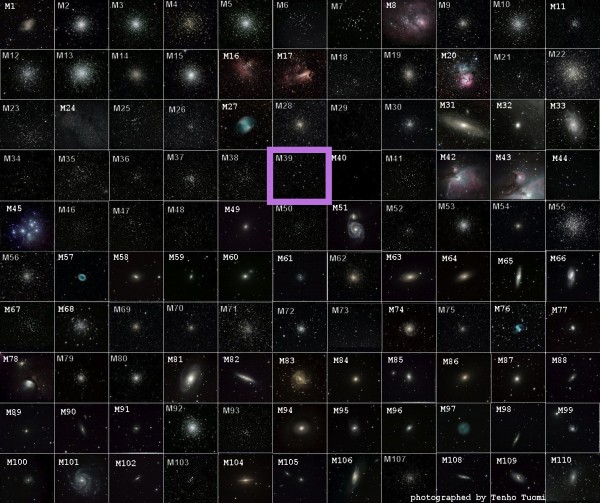 Image credit: Tenho Tuomi of Tuomi Observatory, via http://www.lex.sk.ca/.
Image credit: Tenho Tuomi of Tuomi Observatory, via http://www.lex.sk.ca/.
Today, we take an in-depth look at one of the brightest and closest star clusters in the entire night sky, one that -- despite being visible to the naked eye -- went unrecorded until Messier himself catalogued it in 1764. Let's take a tour of Messier 39, starting with how to find it.
 Image credit: me, using the free software Stellarium, via http://stellarium.org/.
Image credit: me, using the free software Stellarium, via http://stellarium.org/.
Although one of the most prominent collections of stars in the night sky is known as the Summer Triangle -- consisting of the dominant stars (in its portion of the sky) Altair, Deneb and Vega -- it's actually visible after sunset well into autumn and even early winter for the Northern Hemisphere! The galactic plane passes through the summer triangle, and most of the open star clusters contained within our galaxy are found in the galactic plane, and Messier 39 is no exception to this rule.
To find it, draw an imaginary line from Vega (the brightest one) to Deneb (on the short side with Vega), and continue to head a little farther in that same direction.
 Image credit: me, using the free software Stellarium, via http://stellarium.org/.
Image credit: me, using the free software Stellarium, via http://stellarium.org/.
The first thing you'll run into is the easily visible naked-eye star, the orange supergiant ξ Cygni, which is nearly along the imaginary line extended along the Vega-to-Deneb path. If you think about Deneb as the bottom of a circle and move clockwise towards ξ Cygni, you'll hit three more (albeit slightly dimmer) naked eye stars as you reach the top of the circle -- ρ Cygni, π2 Cygni, and Azelfafage (also π1 Cygni), in order -- and Messier 39 lies just inside of them.
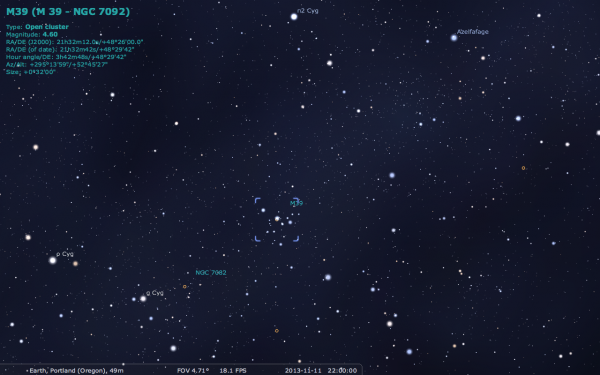 Image credit: me, using the free software Stellarium, via http://stellarium.org/.
Image credit: me, using the free software Stellarium, via http://stellarium.org/.
Although Messier, discovering it in 1764, gave it the very terse description:
Cluster of stars near the tail of the Swan; one can see them with an ordinary telescope...
this actually turns out to be one of the most remarkable objects in his entire catalogue! Let's take a look inside.
 Image credit: John (J.C.) Mirtle of http://www.astrofoto.ca/.
Image credit: John (J.C.) Mirtle of http://www.astrofoto.ca/.
You might first notice the prominent blue stars, and you should: there are about 30 prominent, blue-colored stars identified in M39, the bluest of which is of spectral type A0, the brightest and bluest of all the A-class stars. But one of the things that makes this cluster particularly interesting is that all of the bright stars are blue!
 Image credit: Marcin Paciorek of http://www.astromarcin.pl/.
Image credit: Marcin Paciorek of http://www.astromarcin.pl/.
There are no red, orange or yellow giants, no prominent subgiants, and no stars in general found off of the main sequence!
For those of you who need a reminder, the main sequence is the line on which -- if you plot the colors vs. magnitudes of stars -- you'll find all stars burning hydrogen in their core.
This is exceedingly rare! By this point in a star cluster's life, a star running out of fuel in its core takes some tens of millions of years to go from the main sequence and through the various subgiant and giant stages until it dies in a planetary nebula and white dwarf combination. With hundreds of stars expected in a typical star cluster, finding one without a single evolved star is exceedingly rare!
And yet, here Messier 39 is, doing exactly that.
 Image credit: Jim Mazur's Astrophotography, via http://www.skyledge.net/.
Image credit: Jim Mazur's Astrophotography, via http://www.skyledge.net/.
With the background stars of the galaxy shining in a dim haze behind it, Messier 39 happens to be close, at a distance of just 800 light years, only the Pleiades and Praesepe star clusters are closer objects in the Messier catalogue. And yet, if we take a long exposure to really bring out the background stars, we don't really find many more that appear to be associated with these bright, blue ones! Even though -- based on what we see -- there are around 800 solar masses worth of material in there, we've only definitively identified around 60 stars in this cluster!
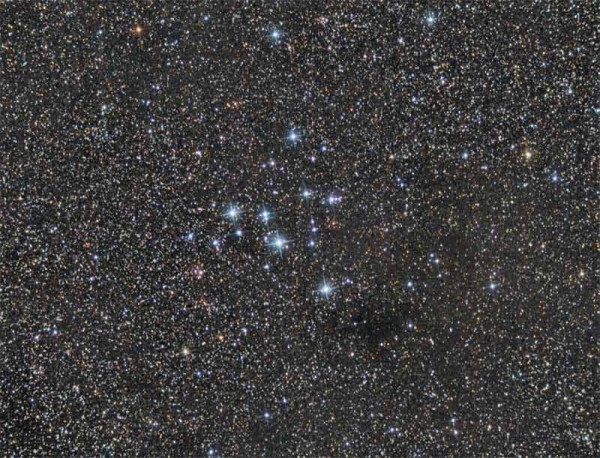 Image credit: Tonk of Cloudy Nights, via http://www.cloudynights.com/.
Image credit: Tonk of Cloudy Nights, via http://www.cloudynights.com/.
Only six of Messier's star clusters appear brighter to the eye, and the brightest of the blue stars here are just barely beyond the limit of human naked-eye vision under the darkest possible skies.
With long-exposure photography, the sight is nothing short of spectacular.
 Image credit: © 2011-2012 Thomas Henne of http://www.distant-lights.at/.
Image credit: © 2011-2012 Thomas Henne of http://www.distant-lights.at/.
Based on the stars that are in there -- and assuming that higher mass ones are missing because they've evolved and disappeared -- we can estimate that this star cluster is around 300 million years old, but there are some uncertainties there.
After all, looking among what appear to be background stars, how many evolved white dwarfs from long-dead O-and-B-class stars are hanging out, invisible because of the incredible density of stars found in the galactic plane?
You'd be very, very smart if you thought to look in the infrared; oftentimes, evolved, cooler stars that are less prominent in the visible will appear bright in the infrared!
Let's have a look at the best IR image out there of M39, thanks to 2MASS!
This infrared image is what allowed us to go from about 30 (visible) stars up to around 60, but that's still a tiny number for an open star cluster! (And it's only seven light-years across; this star cluster would appear tiny if it weren't so ridiculously close!) Did something happen when this cluster was forming to end star formation early? It wouldn't be the only cluster like this, but the more of these objects I go through, the more of an appreciation I have for the sheer diversity of populations of stars that form naturally in the Universe!
My favorite of all the images that exist of M39 comes courtesy of NOAO, the National Optical Astronomy Observatories.
This image -- originally -- comes in an incredibly high resolution; if we take a "slice" through the center, here's what this incomparable star cluster looks like, silhouetted against the backdrop of the galactic plane!
This would make a lousy target for Hubble due to its incredibly large angular size, but that makes it all the more amazing as a target for amateur skygazers! And with that magnificent tour through one of the closest star clusters to us, that will wrap up another Messier Monday! Including today's entry, we've peered at the following Messier objects:
- M1, The Crab Nebula: October 22, 2012
- M2, Messier’s First Globular Cluster: June 17, 2013
- M5, A Hyper-Smooth Globular Cluster: May 20, 2013
- M7, The Most Southerly Messier Object: July 8, 2013
- M8, The Lagoon Nebula: November 5, 2012
- M11, The Wild Duck Cluster: September 9, 2013
- M12, The Top-Heavy Gumball Globular: August 26, 2013
- M13, The Great Globular Cluster in Hercules: December 31, 2012
- M15, An Ancient Globular Cluster: November 12, 2012
- M18, A Well-Hidden, Young Star Cluster: August 5, 2013
- M20, The Youngest Star-Forming Region, The Trifid Nebula: May 6, 2013
- M21, A Baby Open Cluster in the Galactic Plane: June 24, 2013
- M25, A Dusty Open Cluster for Everyone: April 8, 2013
- M29, A Young Open Cluster in the Summer Triangle: June 3, 2013
- M30, A Straggling Globular Cluster: November 26, 2012
- M31, Andromeda, the Object that Opened Up the Universe: September 2, 2013
- M32, The Smallest Messier Galaxy: November 4, 2013
- M33, The Triangulum Galaxy: February 25, 2013
- M34, A Bright, Close Delight of the Winter Skies: October 14, 2013
- M37, A Rich Open Star Cluster: December 3, 2012
- M38, A Real-Life Pi-in-the-Sky Cluster: April 29, 2013
- M39, The Closest Messier Original: November 11, 2013
- M40, Messier’s Greatest Mistake: April 1, 2013
- M41, The Dog Star’s Secret Neighbor: January 7, 2013
- M44, The Beehive Cluster / Praesepe: December 24, 2012
- M45, The Pleiades: October 29, 2012
- M48, A Lost-and-Found Star Cluster: February 11, 2013
- M51, The Whirlpool Galaxy: April 15th, 2013
- M52, A Star Cluster on the Bubble: March 4, 2013
- M53, The Most Northern Galactic Globular: February 18, 2013
- M56, The Methuselah of Messier Objects: August 12, 2013
- M57, The Ring Nebula: July 1, 2013
- M60, The Gateway Galaxy to Virgo: February 4, 2013
- M65, The First Messier Supernova of 2013: March 25, 2013
- M67, Messier’s Oldest Open Cluster: January 14, 2013
- M71, A Very Unusual Globular Cluster: July 15, 2013
- M72, A Diffuse, Distant Globular at the End-of-the-Marathon: March 18, 2013
- M73, A Four-Star Controversy Resolved: October 21, 2013
- M74, The Phantom Galaxy at the Beginning-of-the-Marathon: March 11, 2013
- M75, The Most Concentrated Messier Globular: September 23, 2013
- M77, A Secretly Active Spiral Galaxy: October 7, 2013
- M78, A Reflection Nebula: December 10, 2012
- M81, Bode’s Galaxy: November 19, 2012
- M82, The Cigar Galaxy: May 13, 2013
- M83, The Southern Pinwheel Galaxy, January 21, 2013
- M86, The Most Blueshifted Messier Object, June 10, 2013
- M92, The Second Greatest Globular in Hercules, April 22, 2013
- M94, A double-ringed mystery galaxy, August 19, 2013
- M97, The Owl Nebula, January 28, 2013
- M99, The Great Pinwheel of Virgo, July 29, 2013
- M101, The Pinwheel Galaxy, October 28, 2013
- M102, A Great Galactic Controversy: December 17, 2012
- M103, The Last ‘Original’ Object: September 16, 2013
- M104, The Sombrero Galaxy: May 27, 2013
- M108, A Galactic Sliver in the Big Dipper: July 22, 2013
- M109, The Farthest Messier Spiral: September 30, 2013
Come back next week, where another deep-sky object -- and another unique story about the Universe -- awaits you on Messier Monday!



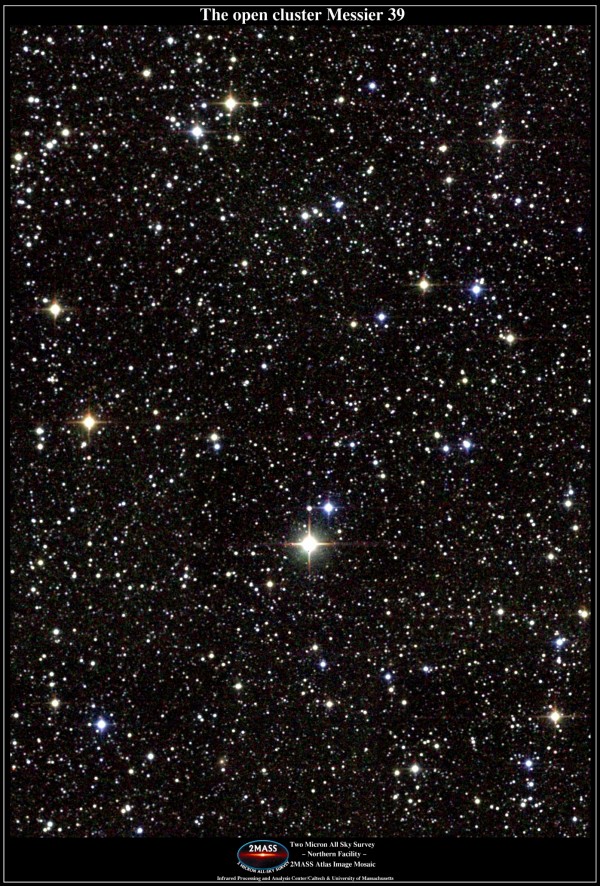
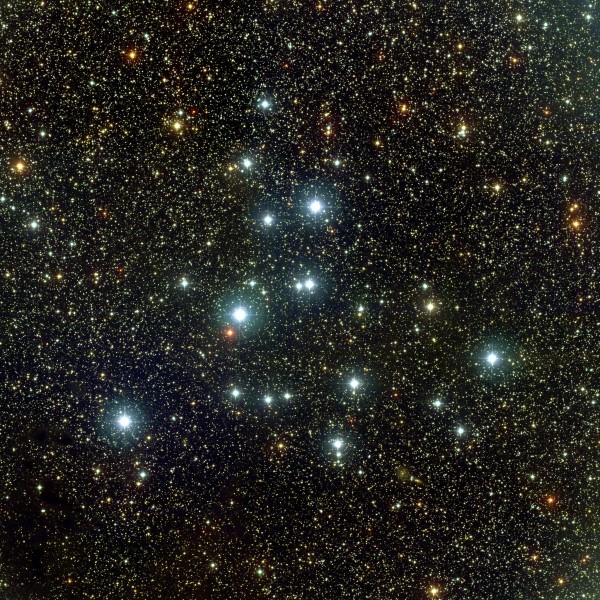

" there are about 30 prominent, blue-colored stars identified in M39, the bluest of which is of spectral type A0, the brightest and bluest of all the A-class stars. "
For comparison, Vega is spectral class A0 (V or main sequence Sirian* dwarf)) and Sirius is spectral class A1 with other bright nearby A type main sequence Sirian* dwarf stars including Altair, Fomalhaut and four of the six stars making up Castor too.
Interestingly, Vega looks bluer and hotter than it really is because we see it pole-on :
http://en.wikipedia.org/wiki/Vega#Rotation
and thus at its hottest and bluest view.
I wonder whether any of the bright blue stars in M39 are similarly seen at their bluest and hottest angle and if so how many of them?
* Sirian used because "white dwarf" means something else entirely.
Isn't it Sirius B that is the dwarf star.
When colloquially called, the dwarf one is called "Sirius" too, but the visible one is not the dwarf.
But Sirius A is a main sequence, not dwarf.
They're using "dwarf" in the sense that is equivalent to "main sequence", or luminosity class V.
No idea what a "Sirian dwarf" is supposed to be, other than an invention to avoid confusion with the other, more commonly used meanings of "dwarf".
Which is just another reason why this sense of "dwarf" should be deprecated. Just say "main sequence".
Question here!
There are around 60 stars in this cluster. In the images, there are hundreds of stars within the confines of the obvious blue stars. How do we know which are in the cluster, and which are foreground/background stars. Has someone mapped the blue/red shifts of all the stars in the image? That would be impressive.
Google Hipparchos, Phil.
CB, Sirius has a white dwarf companion, Sirius B.
More confusion may arise because the Romans called Sirius (the visible one) "The little dog".
Yeah, I know, but there is only one sense in which Vega is a dwarf of any kind, and it's in the sense of "main sequence star", which they said, and also specified class V. Which is two ways in which that sense of "dwarf" is redundant.
But yeah, given the existence of Sirius B, using "Sirian dwarf" to *avoid* confusion with other meanings of "dwarf" is itself a confusing choice.
Vega is in Lyra, not Canis Majoris.
:-)
StevoR called both Vega and Sirius a "Sirian dwarf", aka "main sequence" aka "class V". The fact that they called Vega a dwarf (and also those other things in the same parenthetical) makes it fully clear that they did mean "dwarf" in the sense of "main sequence" which means they were not talking about Sirius B, because Sirius B is not the same kind of dwarf they were talking about.
To make it even more clear, Sirius B is a white dwarf and they specifically said they were not talking about white dwarfs.
So that's it. They were not talking about Sirius B because they were using a confusing (but real) definition of "dwarf".
I don't see what the location of Vega has to do with anything.
No, Steve was trying to shoehorn the same bullshit "argument" for Pluto to be a planet in here.
Pretty damn obvious, really.
The point of Vega was that I was talking about Sirius, not Vega, so there's no point of Vega, despite you bringing it up.
My point with Sirius was regarding the bunk claim of "sirian dwarf", the only match I see is for a fucking *Hamster*, was refutable and retarded.
They brought up Vega, not me, and in so doing made it perfectly clear what kind of dwarf they were talking about. Also they brought up Altair, Fomalhaut, also main-sequence class-V dwarfs.
But you want to talk Sirius. Okay. They were talking about Sirius A, not Sirius B. Sirius B is the white dwarf in the system, not the dwarf. Sirius A is the dwarf.
Except the point is that there's no such classification as "Sirian dwarf".
The only dwarf there is the white dwarf companion.
There's no such thing in astronomy as "Sirian Dwarf".
Also to be clear, "Sirian dwarf" wasn't a "claim". It was an attempt to make what definition of dwarf they were using more clear by distinguishing it from white dwarf.
Obviously it didn't work, and the failure is just a sign that this definition should be deprecated. Nevertheless it is technically correct to call Sirius A a dwarf, just like it is Sol.
"Sirian dwarf" isn't a thing in astronomy, they weren't claiming it was, they made it perfectly clear why they added that phrase (even if it didn't work).
"Dwarf" is a thing, and Sirius A is the dwarf.
Sirius B is the white dwarf.
"“Sirian dwarf” isn’t a thing in astronomy, they weren’t claiming it was, they made it perfectly clear"
Really?
What "they" are you wibbling on about, then?
Because Steve did no such thing.
There is no such thing as Sirian Dwarf unless you're into hamsters.
"Also to be clear, “Sirian dwarf” wasn’t a “claim”. It was an attempt to make what definition of dwarf they were using more clear by distinguishing it from white dwarf."
How about not making up a bullshit claim? Why was there an attempt to make a definition of dwarf that had absolutely no purpose other than to require that definition?
They didn't make a claim. And they didn't make a definition of dwarf, they tried to clarify an already-existing definition of dwarf (and failed). That definition of "dwarf" meaning "main-sequence" already exists.
Sirius A, Vega, Fomalhaut, and Sol are all dwarfs. That is valid terminology.
"They didn’t make a claim."
What definition of claim are you making here?
claim:5. A statement of something as a fact; an assertion of truth
Claim made: Vega is known as a Sirian Dwarf.
"Sirius A, Vega, Fomalhaut, and Sol are all dwarfs."
None of them are "Sirian Dwarfs". That is invalid terminology.
They did not claim it was known as that, they said they were using "Sirian" to distinguish "dwarf" from "white dwarf", the point of explaining such is that it *isn't* known that way. That attempt failed, partly because dwarf terminology is just confusing, partly because 'Sirian' is a confusing adjective to try to use for purpose of clarifying this case, and partly because you were unaware of the definition of "dwarf" they were trying to clarify in the first place so you didn't have the basis to understand what they were clarifying.
But as long as you now understand that you were wrong every time you said that the only dwarf in the system is Sirius B, because actually Sirius A is the dwarf (== main sequence == class V), while Sirius B is a white dwarf which is different, then I consider my contribution to this conversation done.
Please continue to berate StevoR for "claiming" that Vega is a Sirian Dwarf at your pleasure.
"They did not claim it was known as that"
No, he did.
@Wow
uh - WOW. the wikipedia entry for Hipparchos is kind of astounding. An astronomic education in itself. Definitely a sip from the fire hose.
:-)
It gets tiresome sometimes.
+1 CB
TWNLAA, Greg23.
-42.
"and partly because you were unaware of the definition of “dwarf” they were trying to clarify in the first place "
U gets one internets for fail, CB.